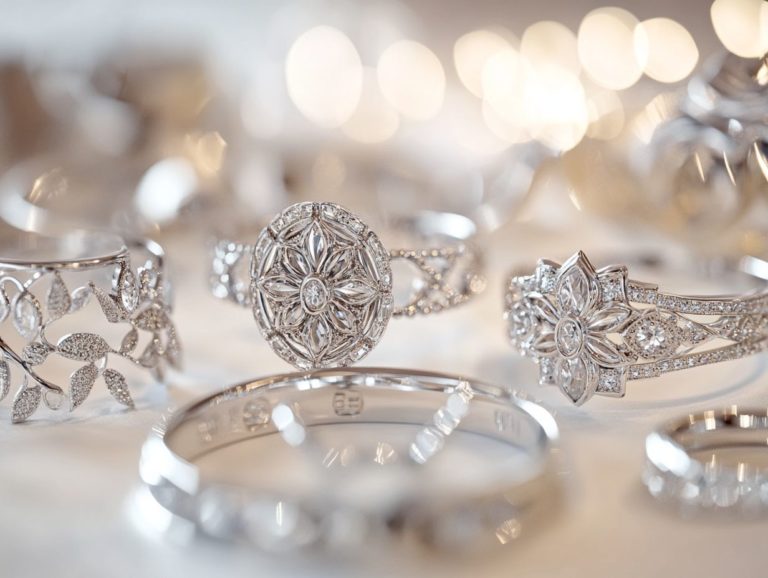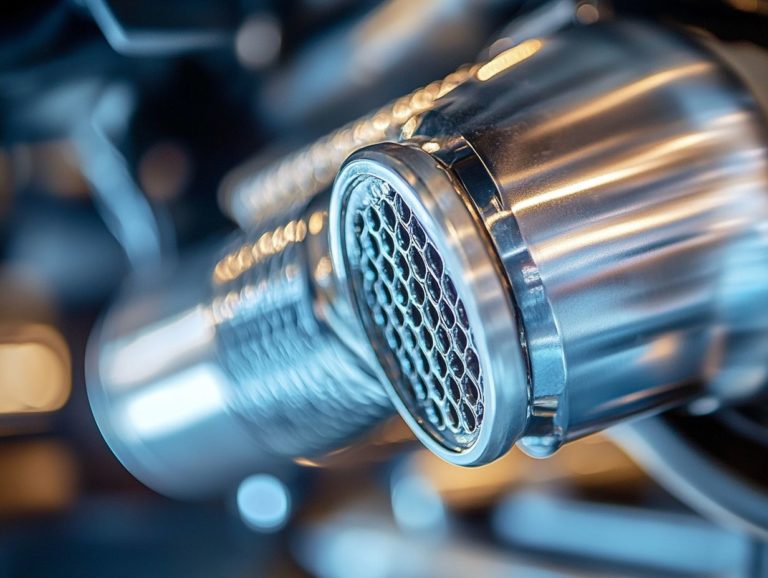How to Assess the Quality of Platinum Products
When it comes to platinum products, quality is paramount for ensuring longevity, value, and satisfaction. This article delves into the significance of quality in platinum, highlighting key factors that influence it, such as purity and manufacturing processes.
You will also find practical tips to help you identify high-quality items and maintain their brilliance over time.
Whether you re a seasoned collector or making your first purchase, understanding these aspects will undoubtedly elevate your shopping experience.
Contents
- Key Takeaways:
- The Importance of Quality in Platinum Products
- Factors that Affect Platinum Quality
- Testing and Certification for Platinum Products
- Identifying High-Quality Platinum Products
- Maintaining the Quality of Platinum Products
- Frequently Asked Questions
- 1. What factors should I consider when assessing the quality of platinum products?
- 2. How can I determine the purity of platinum in a product?
- 3. What should I look for in a manufacturer’s reputation when assessing the quality of platinum products?
- 4. Can I assess the quality of a platinum product based on its weight?
- 5. Are there any red flags to watch out for when assessing the quality of platinum products?
- 6. How can I tell if a platinum product is well-crafted?
Key Takeaways:
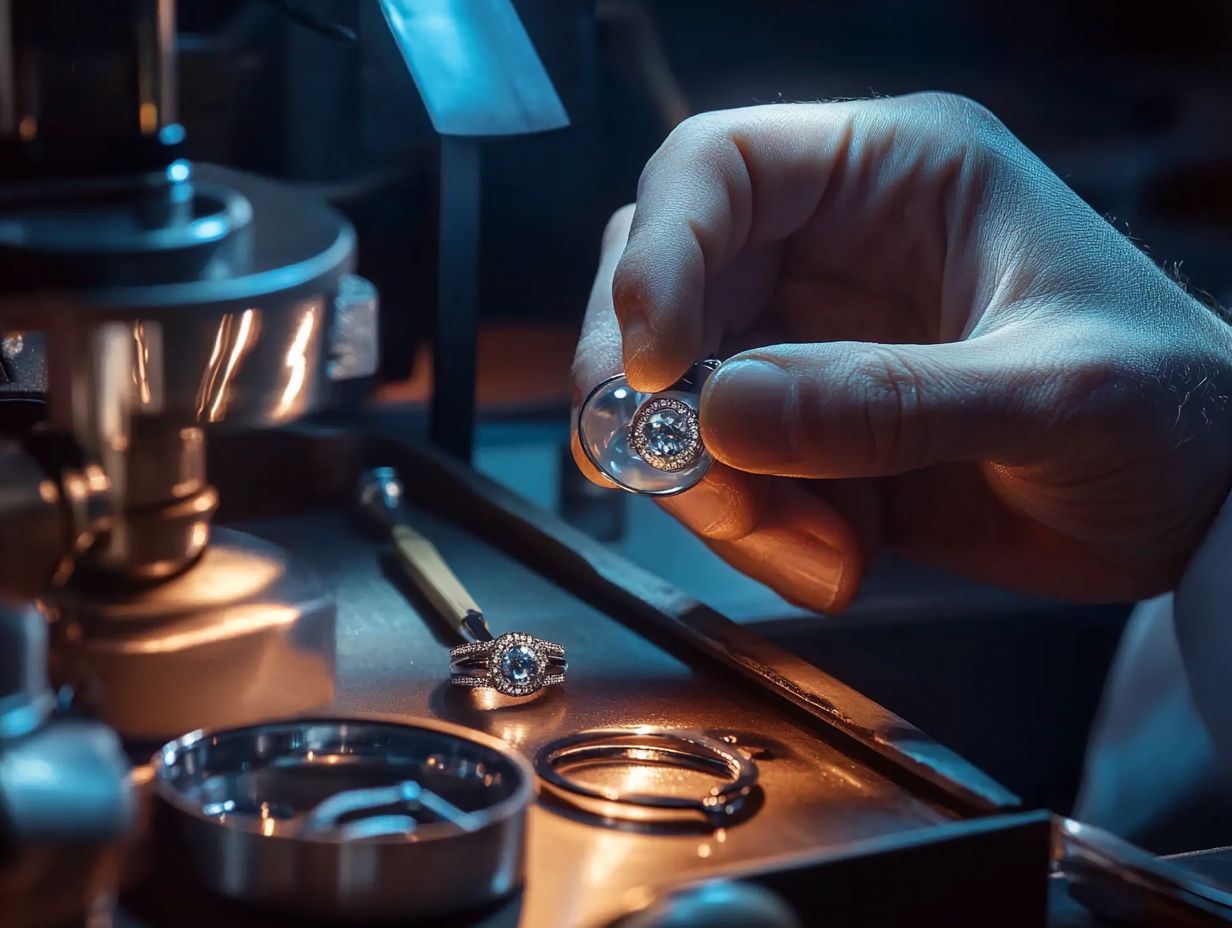
- Quality is crucial in platinum products because it determines their value and durability.
- Purity, composition, and manufacturing processes are key factors that affect the quality of platinum products.
- When shopping for platinum products, look for industry certifications and use common testing methods to evaluate their quality.
The Importance of Quality in Platinum Products
Quality reigns supreme when it comes to platinum products. These exquisite pieces of jewelry, like engagement rings and wedding bands, symbolize lasting commitment and serve as investments in your future.
With platinum’s unique properties skin-friendly and scratch-resistant it’s no wonder this metal is a favored choice for custom jewelry that combines breathtaking aesthetics with remarkable durability.
In an age where precious metals often face imitation, recognizing the significance of quality in platinum helps you make a smart investment that you ll love, all while enjoying a timeless piece that endures beautifully.
Why Quality Matters for Platinum Products
Quality is paramount for platinum products, as these exquisite pieces embody both beauty and a significant investment in precious metals.
The craftsmanship and material standards of platinum jewelry play a crucial role in determining its longevity and overall aesthetic appeal. As you evaluate this investment, appreciate how the purity of platinum elevates its desirability and market value. High-quality platinum, often distinguished by a higher purity level, guarantees durability and protects against depreciation, making it a wise addition to any investment portfolio. Additionally, if you’re interested in precious metals, knowing how to assess the value of silver can further enhance your investment strategy.
A meticulously crafted platinum piece is not just an accessory; it is a testament to exceptional artistry. It serves as both a stunning adornment and a strategic asset that can appreciate over time, making it a savvy choice for personal enjoyment and financial security alike.
Factors that Affect Platinum Quality
Understanding the factors that impact platinum quality is crucial for anyone contemplating the purchase of jewelry, engagement rings, or custom pieces. These elements not only shape the visual appeal but also influence the investment value of precious metals like platinum.
Key considerations, such as purity, composition, and the specific metals mixed with platinum, can greatly affect the overall quality and durability of the jewelry, ensuring it remains a treasured addition to your investment portfolio.
Purity and Composition
The purity and composition of platinum play a pivotal role in shaping its desirability, longevity, and overall value as a precious metal.
Know the different purity levels. They are shown in parts per thousand. In terms of platinum jewelry, you might encounter shades like 950, indicating 95% platinum and 5% other metals such as iridium or ruthenium. To further understand how these elements affect value, understanding market trends for paper assets can provide valuable insights. These additions not only enhance durability but also improve scratch resistance.
If you lean towards higher purity levels, like 999, you’re opting for nearly pure platinum—an ideal choice for those who prioritize luxury and investment. The significance of high-purity platinum in the jewelry market is truly remarkable; it offers a brilliant luster, exceptional skin-friendly qualities, and the ability to maintain its value. This makes it an astute decision for both adornment and as a financial asset. Additionally, understanding the value of physical silver can further enhance your investment strategy.
Invest in quality platinum today for a stunning and valuable addition to your collection!
Manufacturing Processes
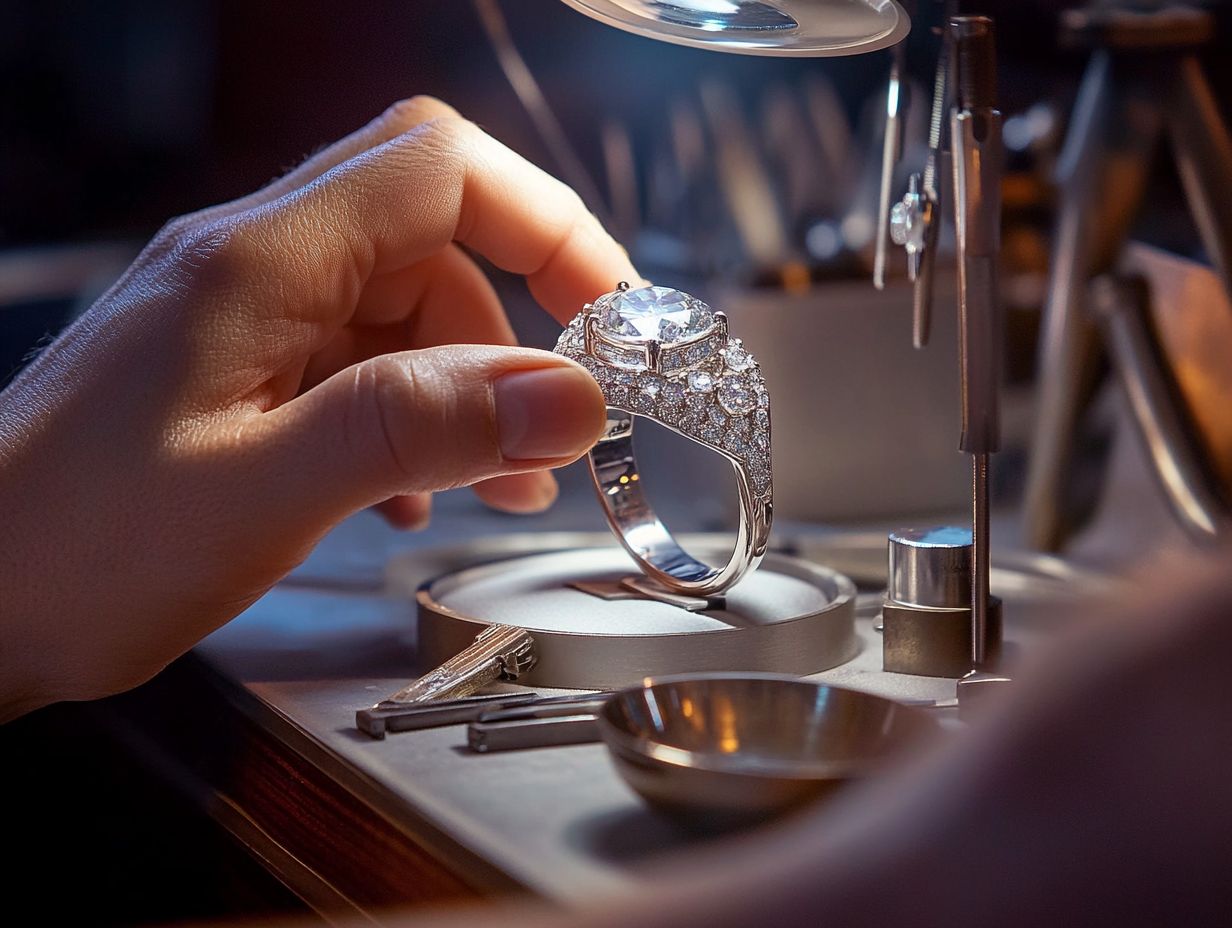
The manufacturing processes involved in creating platinum jewelry are pivotal in determining the quality and market value of the final product.
These methods define the durability and elegance of engagement rings and enhance the overall aesthetic appeal of custom jewelry pieces.
Among the commonly employed techniques, casting allows artisans to craft intricate designs by pouring molten platinum into molds. This process provides exquisite detail and precision.
Conversely, forging shapes the metal through hammering or compressing, resulting in stronger and more resilient pieces.
Each technique has unique advantages, influencing how light interacts with the jewelry. This interaction ultimately captivates the eye of every prospective buyer.
Understanding these processes is essential for anyone eager to appreciate the artistry behind premium platinum creations.
Testing and Certification for Platinum Products
Testing and certification guarantee that your platinum jewelry is authentic and of high quality. This assurance gives you peace of mind when buying significant items, like engagement rings and bespoke jewelry.
A range of testing methods, including non-destructive testing and appraisal techniques, are pivotal in verifying the purity and composition of platinum. They protect you from inferior materials that can tarnish the jewelry market.
Industry Standards and Certifications
Industry standards and certifications are crucial in ensuring the authenticity and quality of platinum jewelry.
These standards outline specifications for purity, composition, and craftsmanship, creating a framework that reputable jewelers must follow.
When you see certifications from recognized bodies, you can feel confident in your purchase. They serve as a testament to the metal’s quality and value.
For example, the Platinum Guild International establishes stringent criteria for its members, helping maintain a consistent level of excellence throughout the industry.
Understanding these certifications enables you to make informed decisions. Your investment is not merely about aesthetics; it guarantees that you’re acquiring something genuine and of the highest quality.
Common Testing Methods
Common testing methods for platinum include the acid test and X-ray fluorescence. Both are designed to confirm the metal’s authenticity and purity.
These techniques are essential in the jewelry market, where discerning buyers seek assurance that their investments are legitimate.
The acid test involves applying a strong acid to the metal; its reaction reveals the purity level.
In contrast, X-ray fluorescence offers a non-destructive method for quick and accurate analysis. This ensures your jewelry piece remains undamaged.
People love this modern technique because it provides immediate results and can identify other alloying metals, giving you insights into the item’s overall quality and value.
Together, these methods significantly contribute to maintaining trust and transparency in the jewelry industry, allowing you to make informed decisions with confidence.
Identifying High-Quality Platinum Products
Identifying high-quality platinum products is crucial for discerning consumers seeking jewelry that embodies long-lasting beauty, durability, and true value as part of their investment portfolio.
As you explore your options, pay attention to key aspects such as visual allure, scratch-resistant qualities, and overall craftsmanship.
These elements work in harmony to define the quality of platinum jewelry, including exquisite engagement rings and bespoke pieces tailored to your taste. Understanding how to evaluate the value of palladium coins can also enhance your knowledge of precious metals in jewelry.
What to Look for When Shopping
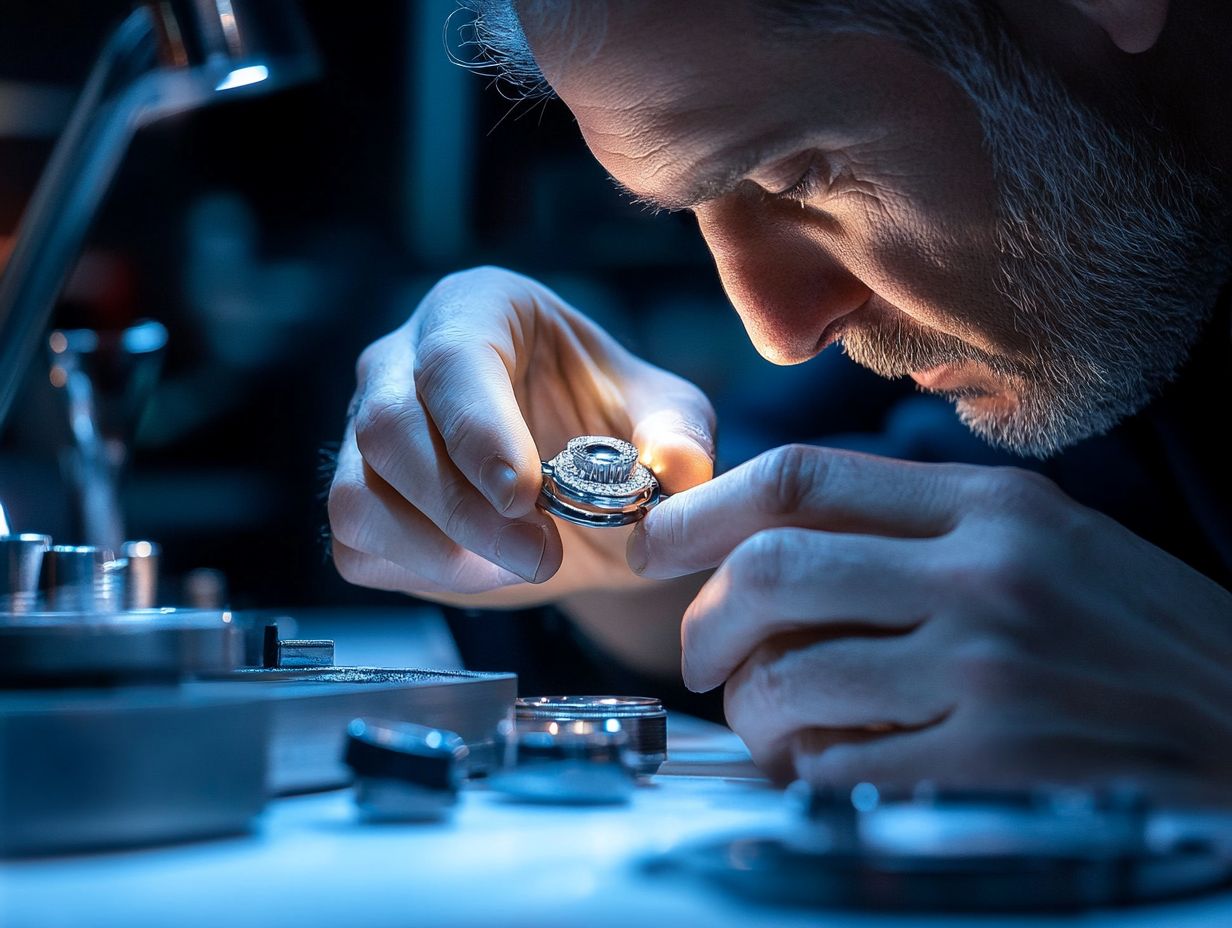
When you re shopping for platinum jewellery, look for these exciting signs of quality to ensure you re making a wise investment in precious metals.
Understanding these factors can greatly influence both the value and longevity of your piece. Start by examining purity marks; these often reveal the metal’s content, with PT950 indicating 95% platinum. For further insights, learn how to calculate the value of your precious metals. Ensure the item comes with a reputable certification, as this guarantees authenticity and adherence to quality standards.
Pay close attention to craftsmanship; well-made jewellery showcases meticulous detail, elevating its aesthetic appeal and potentially affecting its resale value.
By focusing on these critical aspects, you can shop with confidence, knowing you re making a sound financial decision.
Tips for Evaluating Quality
Evaluating the quality of platinum jewellery demands a discerning eye and an understanding of key characteristics to accurately assess value and authenticity.
Start by seeking professional appraisals; these assessments provide a comprehensive evaluation based on purity, craftsmanship, and current market value.
Understanding hallmarks is equally vital; authentic platinum pieces are often stamped with symbols that indicate their purity level, typically marked as 950 for 95% platinum content.
Recognize the importance of craftsmanship; exquisite pieces exhibit remarkable detailing and artistry. By familiarizing yourself with these elements, you enable yourself to make informed choices and approach your investment with confidence.
Maintaining the Quality of Platinum Products
Maintaining the quality of your platinum products is crucial for ensuring their longevity and enduring beauty, especially for treasured items such as engagement rings and wedding bands.
By employing proper cleaning techniques, following care tips, and adhering to appropriate storage guidelines, you can preserve the distinctive attributes of your platinum jewellery. This not only keeps your pieces looking exquisite but also allows them to remain a valued component of your investment portfolio.
Cleaning and Care Tips
Caring for your platinum jewellery involves specific techniques crucial for maintaining its shine and luster over time.
To keep that brilliant appearance intact, establish a routine cleaning regimen that effectively removes dirt and tarnish without causing damage. Gentle cleaning solutions, like a mild soap mixed with warm water, work wonders, while a soft bristle brush allows you to reach intricate details effortlessly.
Avoid abrasive cleaners or harsh chemicals that could scratch the surface. Regularly inspect your pieces for loose stones or signs of wear to prevent more extensive repairs down the line.
Additionally, storing your platinum items separately ensures they remain scratch-free and in pristine condition.
Storage and Handling Guidelines
Proper storage and handling guidelines are vital for preserving the exquisite quality of your platinum jewellery and preventing unsightly scratches or damage.
To maintain the luster and charm of this precious metal, store your platinum pieces in a dedicated jewelry box featuring soft compartments or a tarnish-resistant lining. Consider using protective cases specifically designed for delicate items; these can make a world of difference.
Place each piece in individual pouches or wrap them in a soft cloth for extra protection.
When handling your platinum jewellery, minimize contact with harsh chemicals, oils, or abrasive surfaces. This thoughtful approach extends the life of your cherished pieces and keeps them looking stunning for years to come.
Frequently Asked Questions
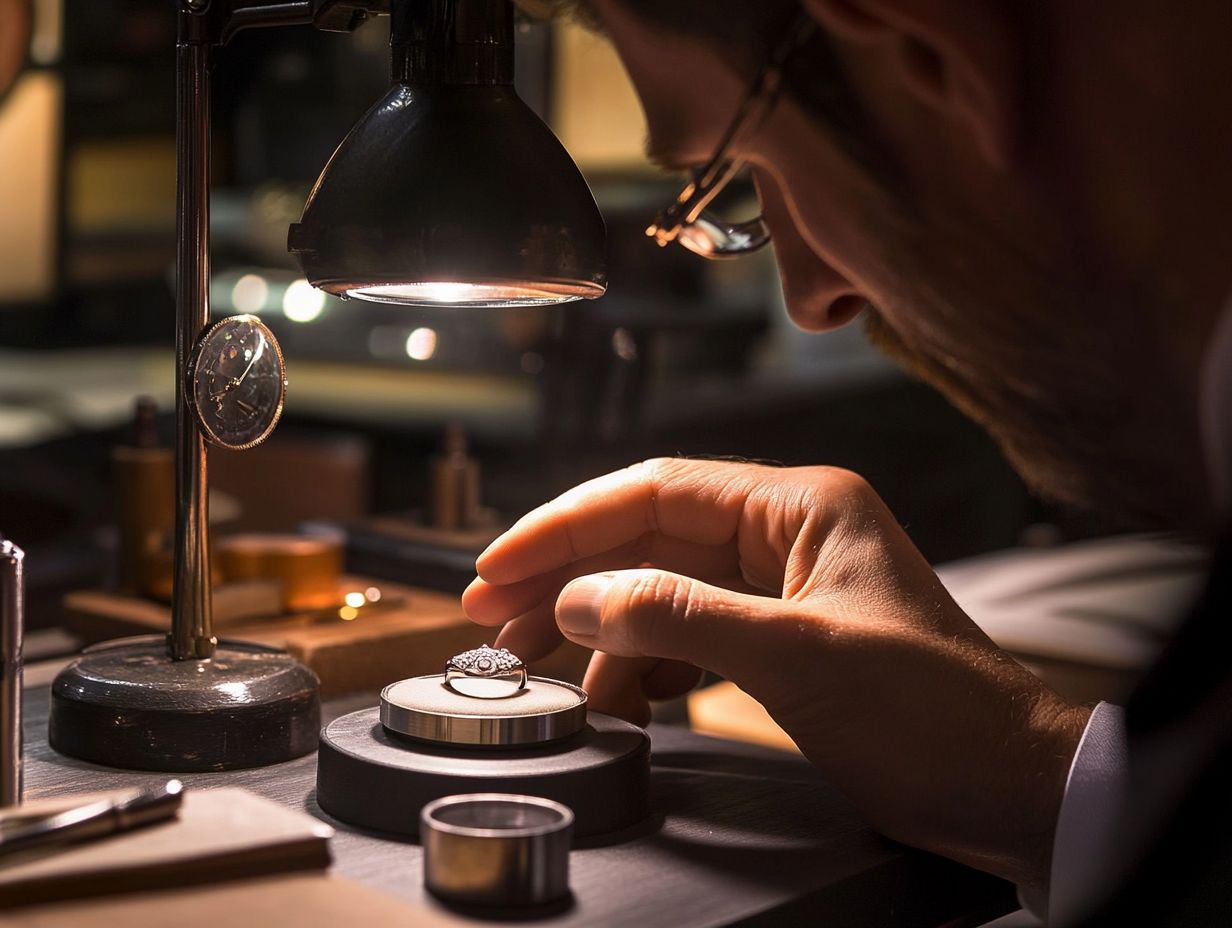
In summary, look for purity marks, reputable certifications, and flawless craftsmanship when shopping for platinum jewellery. Remember to care for your pieces with proper cleaning, storage, and handling techniques to maintain their beauty and value.
Ready to invest in platinum jewellery? Start your journey today with confidence!
1. What factors should I consider when assessing the quality of platinum products?
To assess the quality of platinum products, consider the purity and grade of the platinum. Check the manufacturer’s reputation, craftsmanship, and any added features like durability.
2. How can I determine the purity of platinum in a product?
The purity of platinum is measured in parts per thousand. Look for a stamp or hallmark on the item showing how pure it is, like “950” for 95% pure platinum.
3. What should I look for in a manufacturer’s reputation when assessing the quality of platinum products?
Research the manufacturer’s reputation for high-quality, authentic platinum products. Look for customer reviews and trust badges they may have received.
4. Can I assess the quality of a platinum product based on its weight?
Weight can indicate quality, but it s not the only factor. A heavier product might contain more platinum, but it could also include added alloys or other materials.
5. Are there any red flags to watch out for when assessing the quality of platinum products?
Yes, watch for red flags like a lack of manufacturer information or stamps. Be cautious of prices that are significantly lower than similar products and vague descriptions.
6. How can I tell if a platinum product is well-crafted?
The craftsmanship of a platinum product significantly impacts its quality. Look for smooth edges, consistent finishes, and intricate details that show attention to detail.











